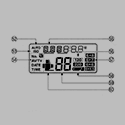|
Factory Factory posted:Well, try disconnecting it, but if it's the exact same results, I'd say the cooler is not mounted properly. Is it set up to blow front to back? How much thermal compound did you use? What voltage are you feeding the CPU, and did you disable Turbo Boost? The cooler has two fans that blow air in a stream through the radiator. The cooler is set up to blow air directly into a rear fan, which then blows out. I didn't precisely measure the amount of thermal paste used, but with the heatsink mounted a small amount of the paste is smooshed out of the sides. Yes, Turbo Boost is disabled. The CPU voltage is currently set to 1.41875 volts.
|
|
|
|

|
| # ? May 9, 2024 18:44 |
|
1) Sounds like you used too much thermal paste. You want this much (the picture is of silver-based paste, so it's the dark grey stuff): 2) That sounds like an awfully high voltage. Not only is that pushing the bounds for safe 24/7 operation, but that's the kind of voltage most people use to go past 4 GHz on a lower-binned i7-920, forget a lower clock on a higher-binned CPU. I would lower that if at all possible.
|
|
|
|
Factory Factory posted:1) Sounds like you used too much thermal paste. You want this much (the picture is of silver-based paste, so it's the dark grey stuff): When I say a small amount, I mean a tiny amount, it's just a thin lip of grey paste at the edges of where the lower part of the heatsink meets the processor. Is it worth it to reapply the paste even in this case? Would it be fair to say that 1.4 volts in the CPU is too much for a base clock speed of 154 (25.0 multiplier)? I'm pretty new at this, so I just manually entered a preset overclocking profile that came with the motherboard into the BIOS.
|
|
|
|
Yeah, I'd say so. Drop that to 1.3V and switch up the clocks to 166 MHz * 23. If that's stable, you can always start pushing the multiplier back up, and the board should handle 166 MHz BCLK no problem. You can probably drop the voltage lower, but start there.
|
|
|
|
Factory Factory posted:Yeah, I'd say so. Drop that to 1.3V and switch up the clocks to 166 MHz * 23. If that's stable, you can always start pushing the multiplier back up, and the board should handle 166 MHz BCLK no problem. You can probably drop the voltage lower, but start there. The 166Mhz*23 at 1.3 CPU volts wasn't stable under Prime95 testing, although the temperature was steady at about 77C. Is there anything else I can try to make the system stable, or will I have to settle for the higher 1.4 CPU voltage at 154Mhz*25?
|
|
|
|
You could bump the voltage slightly and try another stability test? Or lower the FSB slightly?
|
|
|
|
So I have an i7-3770k and the Asus P8Z77-M board. What sort of performance difference could I expect between an I have a hard time understanding the OP's instructions,
|
|
|
|
canyoneer posted:So I have an i7-3770k and the Asus P8Z77-M board. I've had the heatsink in my computer for nearly a week, and this is basically why I haven't messed with anything 
|
|
|
|
Anandtech has a new "Megaroundup" of air and liquid coolers using new testing methodology to better show the differences in noise and be more fair to air coolers. Here's page 7, which compares low-noise performance. The Swiftech H220 and NZXT Kraken X60 turn in quite respectable performance at the top of the pack, though the air coolers are generally leading the liquid coolers.
|
|
|
|
canyoneer posted:So I have an i7-3770k and the Asus P8Z77-M board. 1. Set turbo multiplier to 42 in BIOS. 2. Done. If you want to overclock further you have to put more effort and testing into it. With Sandybridge or Ivybridge chips it's more or less: 1. Setting the RAM at their rated speeds/timings/voltages, with maybe a small voltage bump for 4x modules. Aim for ~1.5V and 1333mhz-1600mhz speeds, so reduce it if you have 2133mhz/1.65V modules or something. You can go up to around 1.65V on sandybridge and a bit about 1.5V with ivybridge, but you have to make sure your RAM voltage is no more than .5V higher than your memory controller's voltage (so the RAM can be 1.6V only if the IMC is given a voltage bump to at minimum 1.1V. If the deviation between RAM and IMC voltage exceeds .5V you risk burning out your CPU's memory controller or instability. Note that increasing IMC voltage will add to CPU heat, so it's better to aim for ~1.52V maximum on the RAM, with a minimum IMC voltage of ~1.05V. There's marginal (at best) benefits to faster RAM, so there's no need to push it. If your RAM will do 1600mhz at 1.5V, you're all set. 2. Set the turbo multiplier to 42X. Leave voltages on auto, or set them manually. Use 5-10 runs of Intelburntest set to maximum for a quick heat/stability test (assuming you got into Windows). If it didn't boot all the way, raise the CPU vcore manually and re-test. Continue raising turbo multiplier and vcore until you max out in heat or voltage*. Around 4.5ghz to 4.6ghz it'll be harder to move up without errors and/or excessive voltage. You may need to set maximum amps or wattage to a high limit (200-300) as an override to prevent TDP throttling, and aim for safer/lower voltages. Higher vcore will require better cooling, so with a 212+ you'll probably max out somewhere around 4.5-4.6ghz. Some people recommend slightly reducing PLL voltage for higher overclocks: Feel free to experiment with this, but I've found it to be marginal at best. Do not alter system agent/SA voltage - Just don't gently caress with it. * Heat maximum: 80C in maximum IntelBurnTest or 72C in Prime95 maxFFT Voltage maximum (safe): Sandybridge CPU: 1.38V Ivybridge CPU: <1.3V Voltage maximum (riskier): Sandybridge CPU: 1.4V Ivybridge CPU: ~1.35V 3. When you have your settings down, you'll want to do an extended Prime95 test for 10-24 hours. Make sure you don't see any errors and that temperatures don't exceed 72C. 4. Your individual board may have other options like VREG settings or settings for vdroop. You'll want to research the overclocking functions of your board to see if there's anything else you can try out. 5. Use offset voltages for CPU vcore (instead of manually-specifying vcore) to keep automatic power-saving operating properly. edit: Or you can win the chip lottery. VVV future ghost fucked around with this message at 21:18 on Apr 30, 2013 |
|
|
|
Not really a response to canyoneer, just a related field trip. I thought I'd enjoy this ASUS motherboard more. It's a Maximus V Gene I got at a slashed open-box price, thankfully with all the accessories still intact and in unopened baggies no less. I decided I'd throw down for it after reading one of the threads here suggesting it was one of those "i loving love computers" boards. I threw my 3770K on it and despite all the ridiculous ways I found to screw it nine ways to Tartarus the setting I enjoyed the most with good stability was the If I had known this was going to be so easy then I wouldn't have spent so much time and effort doing research and spent so much money trying out different configurations of other hardware. I guess it was the adventure that counts? e: nine ways. Nine ways to the bottom. Sidesaddle Cavalry fucked around with this message at 14:07 on Apr 27, 2013 |
|
|
|
I'm thinking of doing the BSEL pin mod on some X5460 Xeons which would increase FSB from 1333 to 1600 and clock speed from 3.16ghz to 3.8ghz. Anyone care to guess if I'm going to be running into voltage problems at that speed given that I don't have control over voltage? The board is a Dell T7400 workstation so no control over voltage through bios. There are pin mods for voltage as well but I don't want to dick with that if I don't have to.
|
|
|
|
That's a really high speed for that architecture, in many cases even with increased voltage and good cooling 3.8GHz isn't possible from that architecture. You could try what I've done with pin modding laptops and set the bios for maximum power saving mode, or any equivilant that sets the multiplier to the lowest possible on bootup and have a program autorun with windows that adjusts it back up to the stock CPU speeds but with the higher FSB.
|
|
|
|
On second thought I think I'm going to go the milder route with E5430s (lower TDP and lower multi). So 2.66 to 3.2 which is within the actual speeds that arch shipped with.
|
|
|
|
I just took off my CPU cooler (CoolerMaster Hyper N520) and reapplied the thermal paste, based on the advice that I applied too much thermal paste previously, and things have gotten much worse. Where before I plateaued around 87C at maximum load, I now top out at around 100C using Prime95 in-place large FFT testing, and idle at around 55C. This is with an Intel Core i7 960 overclocked to 3.8GHz. I'm positive I applied the paste correctly. I cleaned the old paste using Isopropyl alcohol and coffee filters. I put about a pea sized blob of paste on the CPU, I spread it using a flat plastic card and then I mounted the cooler. There was a thin layer that looked more or less exactly like what the tutorial videos show. I don't understand where I went wrong with this.
|
|
|
|
Daysvala posted:I put about a pea sized blob of paste on the CPU, I spread it using a flat plastic card and then I mounted the cooler.
|
|
|
|
That's a relatively-small 4-heatpipe cooler on an overclocked 130W (stock) TDP CPU. With the overclock and depending on voltage, you're only going to get so far with it. Either you have voltage set higher than necessary, you'll need to back off the overclock, or the cooler isn't mounted properly. Slightly too much thermal paste won't cause 20C jumps in temperatures - There's likely something else going on here. Even with perfect thermal paste application you'll still be limited by the cooler itself, so you're either going to have to drop back from the overclock/vcore, replace the cooler, or deal with higher temperatures. future ghost fucked around with this message at 21:13 on Apr 30, 2013 |
|
|
|
Alereon posted:That is way too much thermal paste, so you probably have too paste blocking good contact with the CPU. You should be using a VERY small amount of paste, only enough to spread into a paper-thin, even layer BARELY thick enough to not be transparent. That said you may just need to back off on your overclock. Jesus, okay, I'll take the it apart again and put on a tiny amount. Does the paste need to cover the entirety of the surface of the CPU or is it alright if the paste only covers a portion of the CPU surface in a circle? I'm pretty sure that the cooler is mounted correctly. I don't see how I could possibly gently caress that part up, everything has been tightened to within an inch of it's life and doesn't move when tested. VVV I missed that part; in the video they spread the paste using a clear plastic card, so I assumed it was a good thing to do 
Literal Hamster fucked around with this message at 22:15 on Apr 30, 2013 |
|
|
|
Daysvala posted:I spread it using a flat plastic card and then I mounted the cooler From the OP: quote:I won’t lecture you endlessly about the fine points of application methods, except that you shouldn’t spread the thermal compound yourself before placing the heatsink. Just watch this video and pick one that looks good to you: But yeah, you likely just need to throttle back your overclock.
|
|
|
|
A quick correction to that: Thermal paste MUST be manually spread for direct-touch coolers, because otherwise it will just settle in the gaps between the heatpipes. On other types of heatsinks you can often get away with using the dot/line methods, but spreading yourself over the surface of the IHS will provide the best, most consistent contact since you're not leaving anything to chance. If you don't use WAY too much thermal paste clamping pressure from the mounting system will squeeze any excess out the side and you'll have a beautiful thermal paste imprint.
Alereon fucked around with this message at 22:36 on Apr 30, 2013 |
|
|
|
Alereon posted:A quick correction to that: Thermal paste MUST be manually spread for direct-touch coolers, because otherwise it will just settle in the gaps between the heatpipes. On other types of heatsinks you can often get away with using the dot/line methods, but spreading yourself over the surface of the IHS will provide the best, most consistent contact since you're not leaving anything to chance. If you don't use WAY too much thermal paste clamping pressure from the mounting system will squeeze any excess out the side and you'll have a beautiful thermal paste imprint. I'm pretty clueless about the different types of heatsinks; my cooler has a copper faceplate which makes contact with the surface of the CPU, and has ~4 pipes which run out of that copper faceplate and into the radiator unit. Does this fall under the category of direct-touch?
|
|
|
|
Daysvala posted:I'm pretty clueless about the different types of heatsinks; my cooler has a copper faceplate which makes contact with the surface of the CPU, and has ~4 pipes which run out of that copper faceplate and into the radiator unit. Does this fall under the category of direct-touch? There are direct touch plates that actually are flat. This is called witchcraft. Use your brain and look at the drat plate. If it's got big crevices, the kind that happen when two different pieces come together, spread it yourself (or apply razor-thin lines to the pipes themselves). If not, if it's a solid thing, let it do the spreading.
|
|
|
|
Daysvala posted:I'm pretty clueless about the different types of heatsinks; my cooler has a copper faceplate which makes contact with the surface of the CPU, and has ~4 pipes which run out of that copper faceplate and into the radiator unit. Does this fall under the category of direct-touch?
|
|
|
|
So, after a long long time of being too lazy to upgrade my rig I've - thanks to the PC Building thread - now made the jump from my trusty Athlon64 3200+ (lol) to a shiny i5 3570K. After getting over the fact that my BIOS now has mouse, let alone friggin mousewheel support and seeing how these processors have good OC potential without having to gently caress with the FSB, I've decided to see what kind of extra performance I can reasonably squeeze out of the chip. Long story short, I think I've been successful with it running at 4.4GHz, but have two questions: 1) One of the cores (#1) is under load consistently reporting 5-8°C higher temperatures than the others, e.g. max temps of 66-71-64-64 with Prime95, or 74-81-75-73 with IntelBurnTest. Is this normal (sensor inaccuracy), or did I do something wrong with the thermal paste (air bubble)? Cooler is a CM Hyper 212 EVO, btw. (Also, are you supposed to turn off fan control and let them go at full tilt when doing temperature tests, or just leave it on like I did?) 2) The voltage (VID) reading stumps me a bit as well. Originally I started out with a vcore offset of +0.065 which I've since reduced to +0.02 (haven't tried to put it back to stock yet), but regardless of that setting various tools (Core Temp, HWInfo64) report a VID of 1.1609v when running IntelBurnTest respectively 1.1459v for Prime95. Yet, even though the reported VID is exactly the same, I've noticed significantly reduced temperatures (~5°C) when running lower offset values. What the heck is going on there?
|
|
|
|
1) Normal. If you look at the physical layout of the chip, some cores have more or less stuff around them. Core 0 is next to the IGP and frequently runs a bit cooler, because the IGP works as a sort of a heat sink. Cores 1 and 2 sit in between cores 0 and 3 and are hot-boxed a bit. 2) Also normal. VID reflects what the processor requests from the motherboard VRM, and your voltage adjustments come in via the BIOS/UEFI and don't affect what the processor asks for (hence "Offset," i.e. from what things would be at stock). Vcore (VCC) is the measure of voltage actually delivered.
|
|
|
|
Thanks, checking the Vcore reading in both CPU-Z and HWInfo64 it seems to be even lower than that at just 1.12v 
|
|
|
|
SirViver posted:So, after a long long time of being too lazy to upgrade my rig I've - thanks to the PC Building thread - now made the jump from my trusty Athlon64 3200+ (lol) to a shiny i5 3570K. After getting over the fact that my BIOS now has mouse, let alone friggin mousewheel support and seeing how these processors have good OC potential without having to gently caress with the FSB, I've decided to see what kind of extra performance I can reasonably squeeze out of the chip. You have a really good chip. Delid it and see if you can get 5ghz!
|
|
|
|
amp281 posted:You have a really good chip. Delid it and see if you can get 5ghz!
|
|
|
|
My memory is really hazy but I recall delidding a bunch of early Athlon64s and it was pretty easy to shim the difference of the IHS using washers from the hardware store. I guess back in those days AMD used thermal paste as well and not solder. So were all IHS CPUs in the early days just pasted to the IHS? When did soldering start?
|
|
|
|
I remember somewhere in the prescott era was the first time I heard of someone ripping a die off because it was soldered to the IHS.
|
|
|
|
amp281 posted:You have a really good chip. Delid it and see if you can get 5ghz!  . I'm very happy with the result so far and going any higher seems to very rapidly approach diminishing returns in regards to performance gain vs. voltage/heat increase and chip lifespan degradation (especially the very abrupt kind of degradation you experience when loving up the delidding). At one point earlier in my OC attempts I tried putting it to 4.5GHz @ +0.065v, but it froze the system shortly after loading Windows and I didn't want to bother investigating the cause (probably lack of voltage) when it seems to run perfectly fine at 4.4GHz with near stock voltage. . I'm very happy with the result so far and going any higher seems to very rapidly approach diminishing returns in regards to performance gain vs. voltage/heat increase and chip lifespan degradation (especially the very abrupt kind of degradation you experience when loving up the delidding). At one point earlier in my OC attempts I tried putting it to 4.5GHz @ +0.065v, but it froze the system shortly after loading Windows and I didn't want to bother investigating the cause (probably lack of voltage) when it seems to run perfectly fine at 4.4GHz with near stock voltage. I'm also kinda concerned (though maybe unjustified?) about the VRMs on the motherboard since they have no heatsink and unlike the stock cooler the 212 EVO doesn't point at the mobo either, further reducing their cooling, so I'm glad if I can avoid pushing any more power through there.
|
|
|
|
craig588 posted:I remember somewhere in the prescott era was the first time I heard of someone ripping a die off because it was soldered to the IHS. Prescott was a total waste of time, and I can barely believe Intel squeezed it out. Anyone who "upgraded" from Northwood to Prescott was pissing money up the wall, and heating their room.
|
|
|
|
HalloKitty posted:Prescott was a total waste of time, and I can barely believe Intel squeezed it out. Anyone who "upgraded" from Northwood to Prescott was pissing money up the wall, and heating their room. The SL6Z3 Northwood was another really respectable overclocker 3.6GHz and 300Mhz FSB. If the 8x5 chipsets didn't scale so well it might have made the higher multipliers more appealing. It really sucked for people who early adopted the 1,000$ 3GHz chip that had a 23X mutiplier for a factory 133MHz FSB. craig588 fucked around with this message at 18:10 on May 1, 2013 |
|
|
|
For all that Pentium 4 gets bashed as running hot, the TDP range for Prescott was only 84-115W. It's relatively easy to get a GPU that uses as much power as a stock-clocks Prescott system by itself. I think a lot of what has changed is better power supplies, better average power under moderate loads, and, most of all, better cooling technologies (like heatpipes).
|
|
|
|
craig588 posted:The SL6Z3 Northwood http://www.xbitlabs.com/news/cpu/display/news6375.html (electomigration issues with Intel Northwood processors - seemed to affect the A & B revisions more than the 800mhz FSB 'C' stepping chips). future ghost fucked around with this message at 23:38 on May 1, 2013 |
|
|
|
Factory Factory posted:For all that Pentium 4 gets bashed as running hot, the TDP range for Prescott was only 84-115W. It's relatively easy to get a GPU that uses as much power as a stock-clocks Prescott system by itself. I think a lot of what has changed is better power supplies, better average power under moderate loads, and, most of all, better cooling technologies (like heatpipes). I guess it's more that Prescott was slower for almost every type of workload than Northwood at the same clock, all while using more power. Even though it was made on a smaller process.
|
|
|
|
Ok, one last harpertown question. What are the chances of an E5450 running at 3.6ghz on stock voltage? How about an E5440 at 3.4ghz? I couldn't find any examples of people doing it.
Shaocaholica fucked around with this message at 04:35 on May 3, 2013 |
|
|
|
I finally got my NH-U12S today to replace my clicking Hyper 212+, and  holy hell this thing is quiet. I'm used to my Hyper 212+ being stuck on full (some weird bug with Extreme4 Z77s I guess?), and with this cooler, variable fan speeds are actually possible. Also shaved a few degrees of my IBT temps, ran 4.4 @ 1.255 (normally I'm at 4.3 @ 1.230) at low-mid 80s instead of low 90's, and much, much quieter. holy hell this thing is quiet. I'm used to my Hyper 212+ being stuck on full (some weird bug with Extreme4 Z77s I guess?), and with this cooler, variable fan speeds are actually possible. Also shaved a few degrees of my IBT temps, ran 4.4 @ 1.255 (normally I'm at 4.3 @ 1.230) at low-mid 80s instead of low 90's, and much, much quieter.And now I'm annoyed at how loud HDDs are 
|
|
|
|
Daysvala posted:Overclocking i7 960 My first question is, are you using your memories xmp profile (if it has one)? Most memory of the era had profiles that weren't written with the triple-channel x58/lga1366 platform in mind. Memory speeds over 1.5-1.6ghz require very high uncore speeds, and to keep things stable a considerable increase in qpi voltage is needed. Thi is made worse by the fact most xmp profiles put qpi voltage much higher than it needs to be (resulting in a very hot cpu).
|
|
|
|

|
| # ? May 9, 2024 18:44 |
|
Endymion FRS MK1 posted:I finally got my NH-U12S today to replace my clicking Hyper 212+, and Just wait until you strap a custom cooler on the videocard and start getting
|
|
|



















